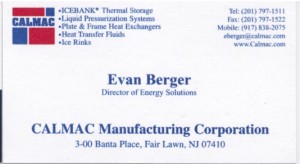 On March 22, 1947 in New York City, Calvin ‘Cal’ MacCracken, a 27 year old New Jersey engineer, graduate of Princeton and MIT, launched his dream—a creative engineering firm named Jet Heet, Inc. Early clients were Whirlpool and Westinghouse, who signed on for research and development work.
On March 22, 1947 in New York City, Calvin ‘Cal’ MacCracken, a 27 year old New Jersey engineer, graduate of Princeton and MIT, launched his dream—a creative engineering firm named Jet Heet, Inc. Early clients were Whirlpool and Westinghouse, who signed on for research and development work.
Two hundred and fifty inventions, eighty patents
Cal was as curious as he was enthusiastic and brilliant. He’d developed the combustion chamber for the world’s first jet engine at GE up in Schenectady, New York. It was Theodore Edison, the son of Thomas Edison, who had urged Cal to pursue his love of engineering. Jet Heet’s credentials were rock solid and impeccable.
Cal moved the company to New Jersey in 1949 and by 1964, he’d renamed it CALMAC. When Cal’s son Mark M. MacCracken joined the company in the mid 1970s, he was just out of college and concerned about the environment; he wanted to make a difference. CALMAC was conducting research and development on solar energy and thermal energy storage was one idea that held real promise.
From fire to ice
On the night of December 23rd, 1980, a massive blaze engulfed the building Cal had bought the previous year. Everything was lost. But in just four weeks, light manufacturing began. Mark M. MacCracken led design and construction efforts for a new building that would take two full years.
“The fire was probably the best thing that could have happened to us,” said Mark.
“Overnight, we had a clean slate and little money. We decided to focus on one area, thermal energy storage.” Cal had invented—and standardized—how a thermal energy storage system could be tied into a conventional cooling system.
Green buildings and thermal energy storage
It was through years of research and development in energy, heating and cooling, that CALMAC developed the idea for thermal energy storage. The system stores energy by making ice at night when electricity rates are low. Ice is stored in CALMAC IceBank® energy storage tanks onsite. The ice is then melted or discharged to cool the building during the day, when rates spike.
Since the rebuilding—and the company’s singular focus on energy storage—the green building industry has taken off. Surveys now show over 2 billion square feet of LEED Certified commercial space worldwide.
Our clients — some of the most admired brands in the world – are committed to green buildings, to sustainable energy sources and to making the world a better place. We’re here to help them reduce their carbon footprint, and in many cases, achieve LEED certification.
Why we’re the world leader in ice storage
The customer experience is everything. Everyone—manufacturing, sales or tech support—makes working with CALMAC an exceptional, personal experience. There’s a spirit here. We have a deep, personal commitment to a family-like way of working. It makes all things possible- the CALMAC advantage.
From the newest person to the 2nd and 3rd generation employee, we work to make the experience better, to make products that are simple, elegant and bullet-proof reliable, the absolute best in the world.
Today, our IceBank® energy storage tanks – pressure tested far beyond any normal lifespan use — are cooling commercial buildings, medical centers, hotels, universities, and corporate headquarters in 4,000 installations in 37 countries. We’re the only manufacturer in the world whose core business is ice-based energy storage.
Making a positive impact
Early on, Cal had purpose: innovation. Mark MacCracken goes one further. “In everything we do,” Mark says today, “we believe in making a positive impact on the world.” To be part of something bigger is the beating pulse of CALMAC. It drove the rebuilding effort and it’s why our people are so dedicated and stay with us for an average of 17 years. They find the support they need to learn and grow as individuals and as professionals.
Mark M. MacCracken served on the board of the United States Green Building Council. He climbed the Matterhorn to raise money for construction of the first planned LEED-certified orphanage and children’s center in Haiti. Father and son, it turns out, know something about scaling heights. Making a positive impact is what we do.
Will you join us in making a greener, smarter future?
Climate change is real. Air pollution and increased numbers of people suffering from asthma are symptoms of our sick planet. That’s why we’re working to help build a brand
new future, where every large building—school, hospital and office—makes use of energy storage. Cool thermal storage will simply be a natural part of everyday life. Storing ice for cooling will be as common as the drinking reservoir or the ice in the freezer.
In the future, energy storage will enable the design and construction of a smarter, more reliable electric grid mostly composed of renewables and green and netzero buildings. Energy storage will be instrumental in the mass scale implementation of renewables. It will enable buildings owners to decide when it is the best time to use energy or sell unused energy back to the grid. Essentially,buildings will become virtual power plants, part of a symbiotic system, that mutually benefits the local consumer as well as the collective society, driving home the health benefits of improved air quality to all and mitigating the effects of greenhouse gas emissions. That’s why we’re working with architects, building owners and engineers to get ready.
Will you join us?
Use hashtag #GreenerFuture and tell the world what you’re doing to make the world a better place.
